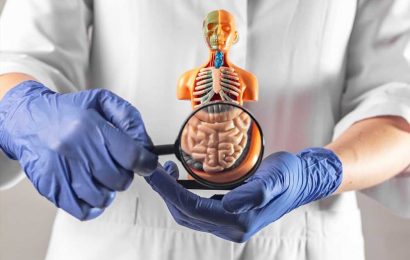In a recent study published in Nature Materials, researchers developed spherical hydrogel inhalation for enhanced lung defense (SHIELD) to protect against severe acute respiratory syndrome coronavirus 2 (SARS-CoV-2) infections.

Background
The continual emergence of highly transmissible SARS-CoV-2 variants has threatened the efficacy of coronavirus disease 2019 (COVID-19) vaccines and therapeutic agents such as antiviral medications and monoclonal antibodies, warranting the development of novel therapies. The airway mucosa provides an initial level of protection against SARS-CoV-2 by the entrapment and elimination of pathogenic organisms and foreign particles. Impaired mucociliary clearance could promote SARS-CoV-2 transmission; thus, mucosal bioadhesive polymer molecules may widen the therapeutic landscape of COVID-19.
About the study
In the present study, researchers used the SHIELD approach for protection against SARS-CoV-2.
The SHIELD particle-mucous interactions enhance particle diffusion and lower SARS-CoV-2 penetration. Particle inhalation is followed by swelling and adhesion. The particles were prepared by the water‐in‐oil emulsion method and comprised N-hydroxysuccinimide ester (PAAc-NHS ester), cross-linked with gelatin, with robust mechanical and mucoadhesive properties.
Scanning electron microscopy (SEM), immunohistochemistry (IHC), in vivo imaging system (IVIS), and confocal microscopy analyses were performed to assess swelling dynamics and volume changes. The particles were tracked by labeling them with Cyanine7 dye, and the particle stability was assessed. In addition, Fourier-transform infrared (FTIR) spectroscopy analysis was performed. Mucous from the stomach of porcine animals was obtained to investigate whether mucosal barrier protection could be reinforced using the SHIELD method.
Using three-dimensional airway models, particle-mucin interactions were further evaluated by wheat germ agglutinin staining. Polystyrene beads, sized similarly to SARS-CoV-2, were generated using a nebulizer and used for simulating SARS-CoV-2 penetration in the mucosa.
The protection conferred by SHIELD was tested in mice challenged with SARS-CoV-2 pseudoviruses, comprising D614G, N501Y, K417N, and E484K mutations, after four hours, eight hours, and 24 hours of 3.0 mg/kg SHIELD inhalation. Further, SHIELD-induced protection was assessed against the H1N1 flu virus and mouse pneumonia virus in mice and the post-SARS-CoV-2 infection scenario.
SHIELD biocompatibility was evaluated in cell culture experiments. To determine the effect of SHIELD on mucociliary elimination functions, the murine animals received acute (two hours) or long-term (regular inhalation for 14 days) SHIELD therapy. The pilot study was performed using non-human primates challenged with the ancestral SARS-CoV-2 Wuhan-Hu-1 strain and the SARS-CoV-2 Delta variant. Nasal swabs and bronchoalveolar lavage samples were obtained on days 1.0, 2.0, 4.0, and 7.0.
Drug Discovery eBook

Enzyme-linked immunosorbent assays (ELISA) were performed to measure the secretory immunoglobulin A (sIgA) levels in the bronchoalveolar lavage (BAL) fluid. Viral load was determined using reverse-transcription PCR (RE-PCR) specific for subgenomic ribonucleic acid (sgRNA). Pulmonary SARS-CoV-2 RNA levels were determined by in situ ribonucleic acid hybridization.
Results
The SHIELD inhalation particles were delivered as a dry powdered (powder size <5.0 μm, particle diameter 0.5 to 5.0 μm) inhaler, and the dense hydrogel crosslinked structure formed by the particles post-hydrous swelling, coated bronchi and bronchioles, enhanced particle diffusion and limited SARS-CoV-2 penetration. The SHIELD therapy protected mice challenged with SARS-CoV-2 pseudoviruses comprising mutated spike (S) proteins.
Of striking interest, among African green monkeys, the protection of one SHIELD inhalation lasted for ≤8.0 hours against the Wuhan-Hu-1 strain and the Delta variant. SHIELD, comprising food-grade substances, did not alter respiratory function. The particle diameter favored particle deposition in deep pulmonary tissues. After swelling, particle volume increased by 10-fold in 10.0 minutes, and identical swelling was observed in the BAL samples. Particle fluorescence was stable for up to 3.0 days.
The finding indicated that mucoadhesion occurred on particle contact with wet mucosal surfaces. Particle swelling commenced at the initiation of mucoadhesion, facilitated by the anionic carboxylic acid molecules of the N-hydroxysuccinimide ester. The ester groups could adhere to surfaces by coupling with the mucosal primary amines. The SHIELD particles increased the modulus of elasticity and viscosity of mucous and reduced the Brownian motion of polystyrene beads.
SHIELD protected mice against the H1N1 flu virus and the mouse pneumonia virus; however, SHIELD’s efficacy in the post-SARS-CoV-2 infection scenario was minimal. Cellular viability of 95% was observed even at concentrations of 10.0 mg ml–1). Tracheal and bronchial tissues obtained from mice showed regular morphology, indicative of SHIELD safety.
SHIELD particles had a minimal impact on mucociliary elimination in the lungs and formed short-term crosslinks with mucus, inducing transient mucosal modification. SHIELD did not affect mucosal immunity levels. SHIELD-treated animals showed 50.0-fold to 300.0-fold lesser viral load than controls and were protected against Wuhan-Hu-1 and Delta. SHIELD reduced pulmonary fibrosis, SARS-CoV-2 nucleocapsid (N) protein levels, SARS-CoV-2 replication, and SARS-CoV-2 infection, with a lowering of the cluster of differentiation 206+ macrophage counts in a non-toxic manner.
Conclusion
Overall, the study findings showed that the SHIELD approach could effectively and safely protect against respiratory pathogens such as SARS-CoV-2, without altering pulmonary function, by enhancing mucosal diffusional properties to physically protect against COVID-19.
The approach is easy to use and suitable for regular administration using cost-effective inhalation devices. SHIELD could be considered an adjunct to face masks, can protect at times when masks are not worn (e.g., during drinking or eating), and could be highly beneficial for children showing mask-wearing hesitancy.
- Mei, X. et al. (2023) "An inhaled bioadhesive hydrogel to shield non-human primates from SARS-CoV-2 infection", Nature Materials. doi: 10.1038/s41563-023-01475-7. https://www.nature.com/articles/s41563-023-01475-7
Posted in: Medical Science News | Medical Research News | Disease/Infection News
Tags: Antibodies, Bronchi, Cell, Cell Culture, Children, Confocal microscopy, Coronavirus, Coronavirus Disease COVID-19, covid-19, Efficacy, Electron, Electron Microscopy, ELISA, Enzyme, Fibrosis, Flu, Fluorescence, Food, H1N1, Hybridization, Hydrogel, IHC, Imaging, immunity, Immunoglobulin, Immunohistochemistry, in vivo, Lungs, Macrophage, Microscopy, Morphology, Pneumonia, Protein, Pulmonary Fibrosis, Respiratory, Ribonucleic Acid, RNA, SARS, SARS-CoV-2, Severe Acute Respiratory, Severe Acute Respiratory Syndrome, Spectroscopy, Stomach, Syndrome, Transcription, Virus, Wheat

Written by
Pooja Toshniwal Paharia
Dr. based clinical-radiological diagnosis and management of oral lesions and conditions and associated maxillofacial disorders.
Source: Read Full Article


